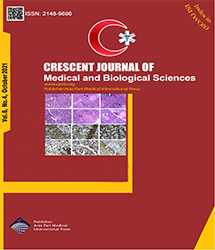
| Original Article | |
| Effects of Hydroalcoholic Extracts of Cloves (Syzygium aromaticum) on the Serum Biomarkers, Antioxidant Status, and Histopathological Changes of Kidneys in Diabetic Rats | |
| Seyd-Hosein Abtahi-Eivari1, Majid Shokoohi2,3, Mohammad Ghorbani1, Monireh Halimi3, Hossein Hajizadeh4, Tala Pourlak3, Javad Bahrami5, Zohreh Ghoreishi6 | |
| 1Department of Basic Sciences, Faculty of Medicine, Gonabad University of Medical Sciences, Gonabad, Iran 2Department of Anatomical Sciences, Faculty of Medicine, Tabriz University of Medical Sciences, Tabriz, Iran 3Department of Pathology, School of Medicine, Tabriz University of Medical Sciences, Tabriz, Iran 4Department of Nutrition, Faculty of Nutrition and Food Sciences, Tabriz University of Medical Sciences, Tabriz, Iran 5Department of Environmental Health Engineering, Faculty of Health, Zanjan University of Medical Sciences, Zanjan, Iran 6Nutrition Research Center, Department of Clinical Nutrition, School of Nutrition and Food Sciences, Tabriz University of Medical Sciences, Tabriz, Iran |
|
|
CJMB 2021; 8: 269-275 Viewed : 4003 times Downloaded : 5071 times. Keywords : Cloves, Diabetes, Lipid profile, Antioxidant status, Kidney damages |
|
| Full Text(PDF) | Related Articles | |
| Abstract | |
Objectives: The purpose of this study was to assess the possible impact of hydroalcoholic extracts of cloves (Syzygium aromaticum) on glucose status, lipid profile, and histopathological changes in the kidneys of diabetic rats. Materials and Methods: Thirty-two rats (male) were distributed into 4 groups (n=8), including one group as healthy control and three diabetic groups. Streptozotocin was used for inducing diabetes (50 mg/kg). Diabetic rats were grouped into a control group (DC), diabetic treated with 4 mg/kg hydroalcoholic extract of S. aromaticum (DSA), and the DG group receiving 5 mg/kg glibenclamide. After the treatment period, the blood samples of the rats were frozen in -70°C for measuring glycemic indices, insulin, lipid profile, some oxidative stress markers, and enzymes with antioxidant properties. Finally, the kidney was removed for the histological study. Results: Control, DSA, and DG groups had significantly lower levels of fasting blood sugar compared to the DC group (P<0.05) while the levels of insulin were significantly lower in the DC, DSA, and DG groups compared to the control group (P<0.05). The serum levels of urea and creatinine statistically reduced in all groups other than the DC group (P<0.05). Conversely, the levels of superoxide dismutase, glutathione peroxidase, and significantly increased in the DSA and DG as compared to the DC group although the serum levels of malondialdehyde statistically decreased in the therapeutic groups. S. aromaticum showed antioxidant properties and protected the kidneys of the experimented rats from renal damages, resulting from diabetes. Conclusions: This study demonstrated that S. aromaticum may have beneficial effects in diabetes through improving glycemic control and lipid profile and preventing diabetes-induced kidney damages. |
Cite By, Google Scholar
Google Scholar
PubMed
Online Submission System
 CJMB ENDNOTE ® Style
CJMB ENDNOTE ® Style
 Tutorials
Tutorials
 Publication Charge
Medical and Biological Research Center
About Journal
Publication Charge
Medical and Biological Research Center
About Journal
Aras Part Medical International Press Editor-in-Chief
Arash Khaki
Deputy Editor
Zafer Akan


















